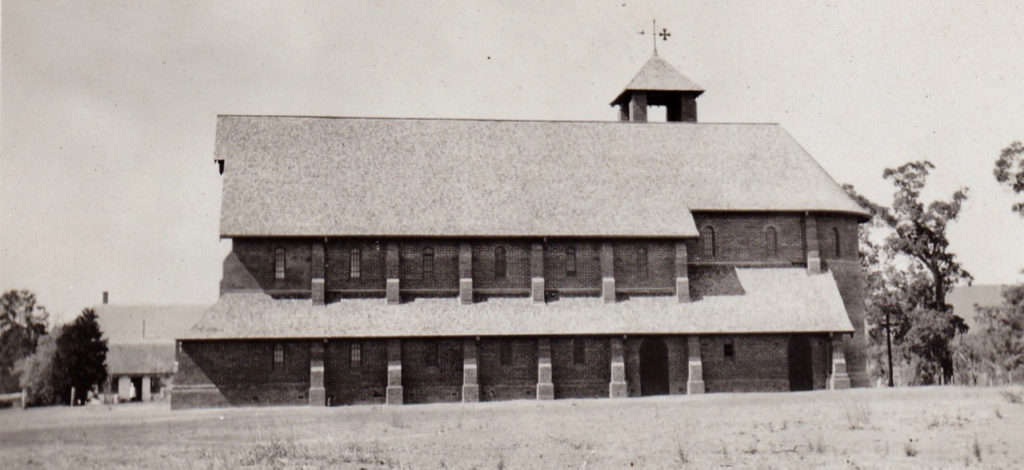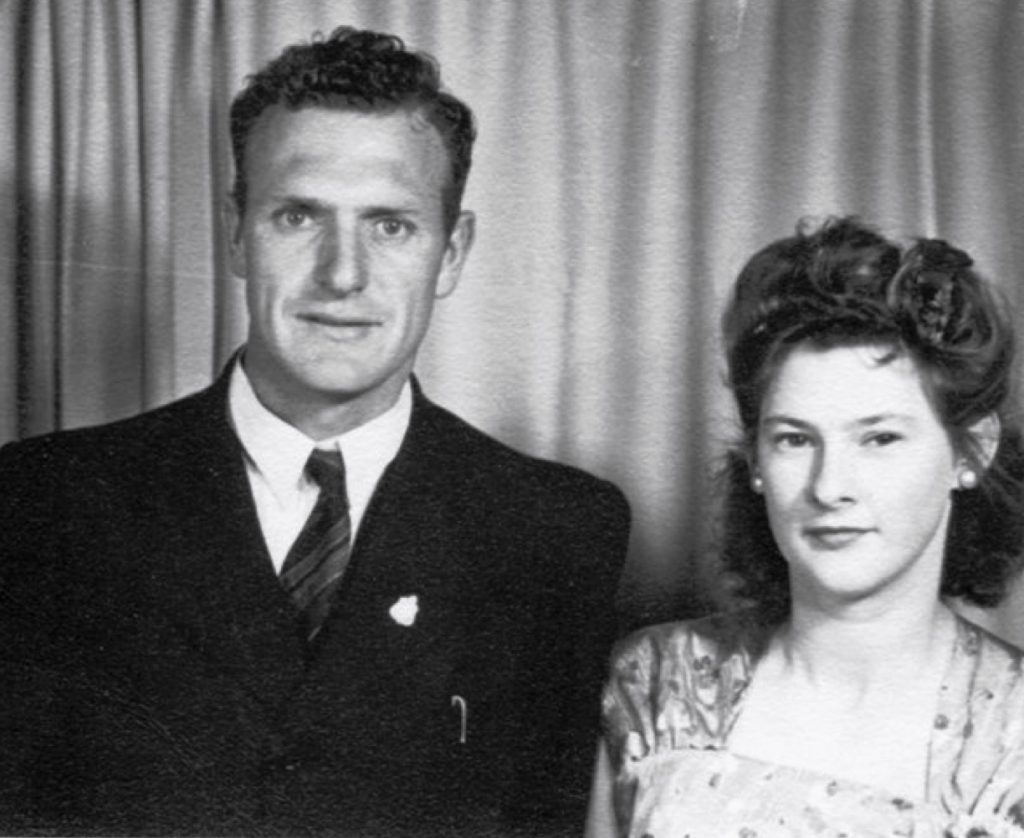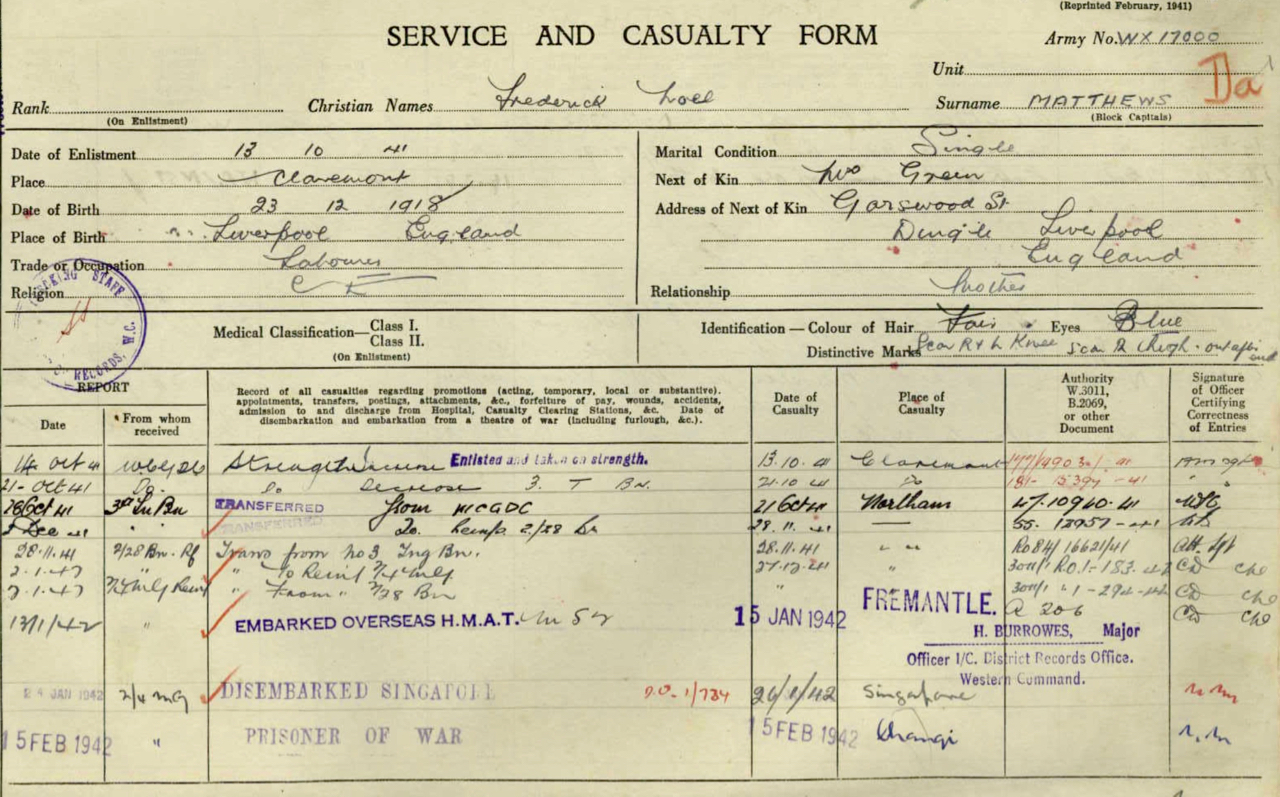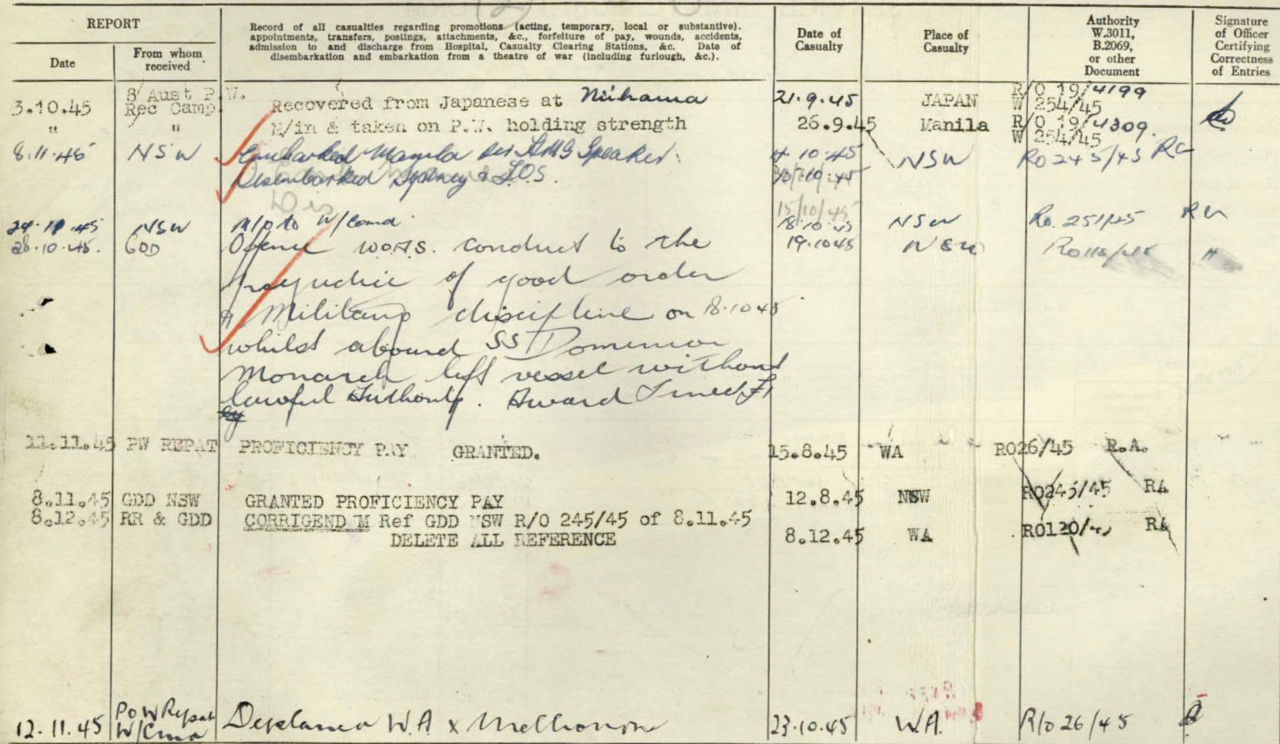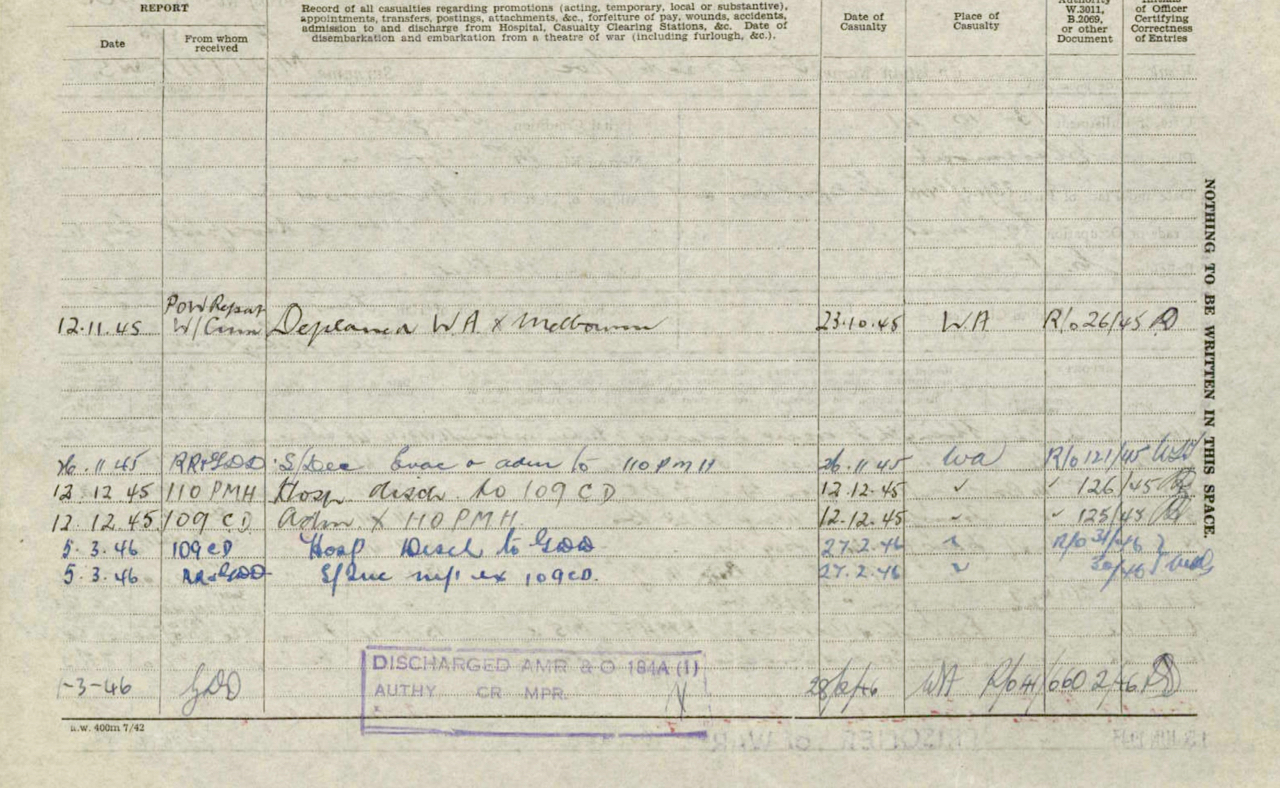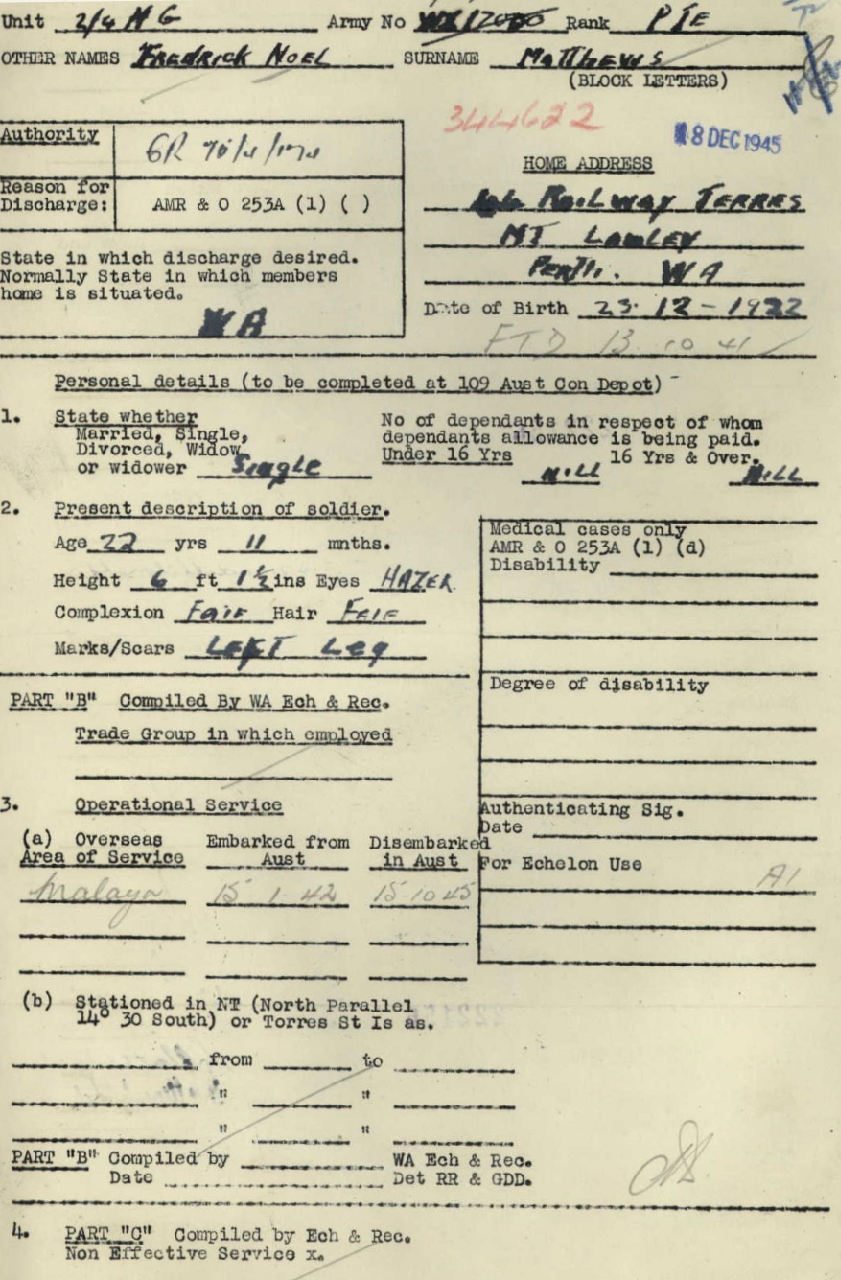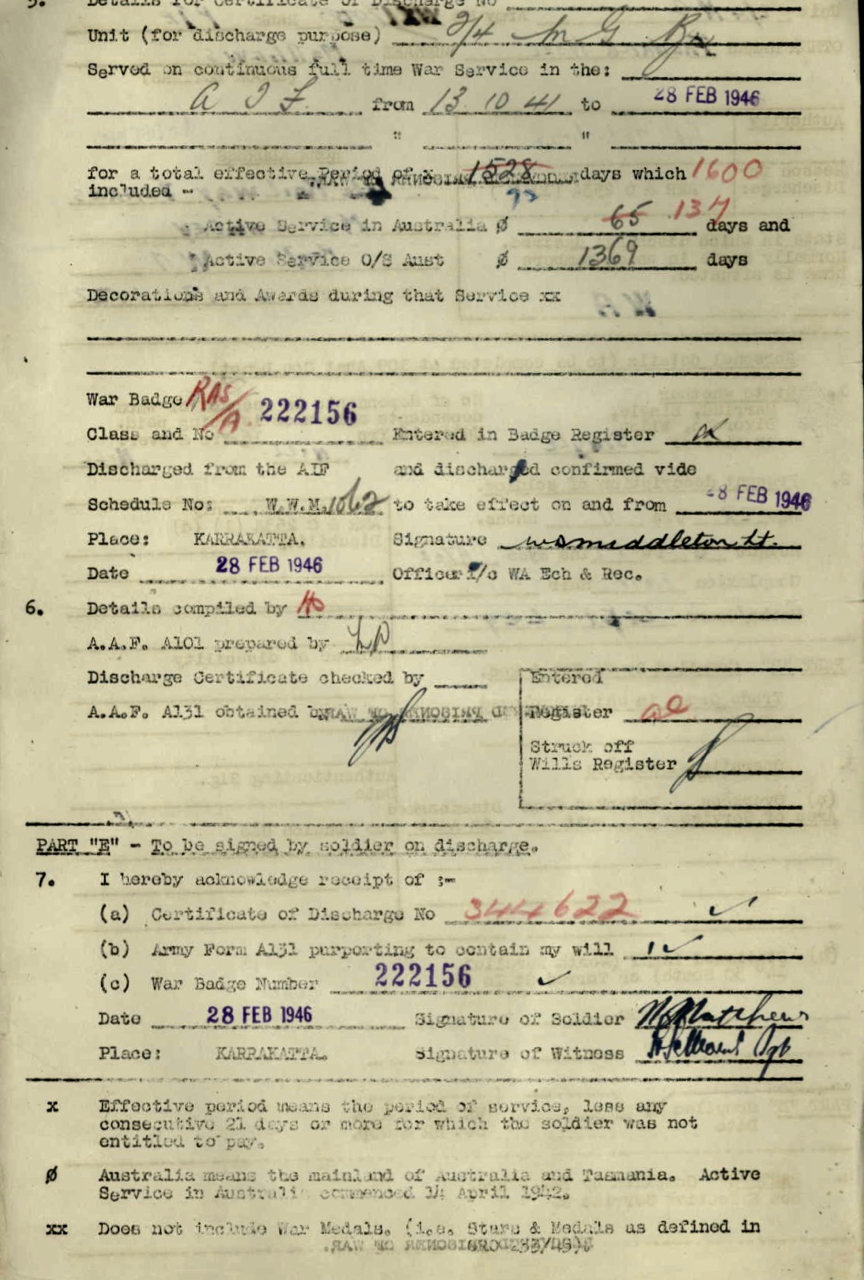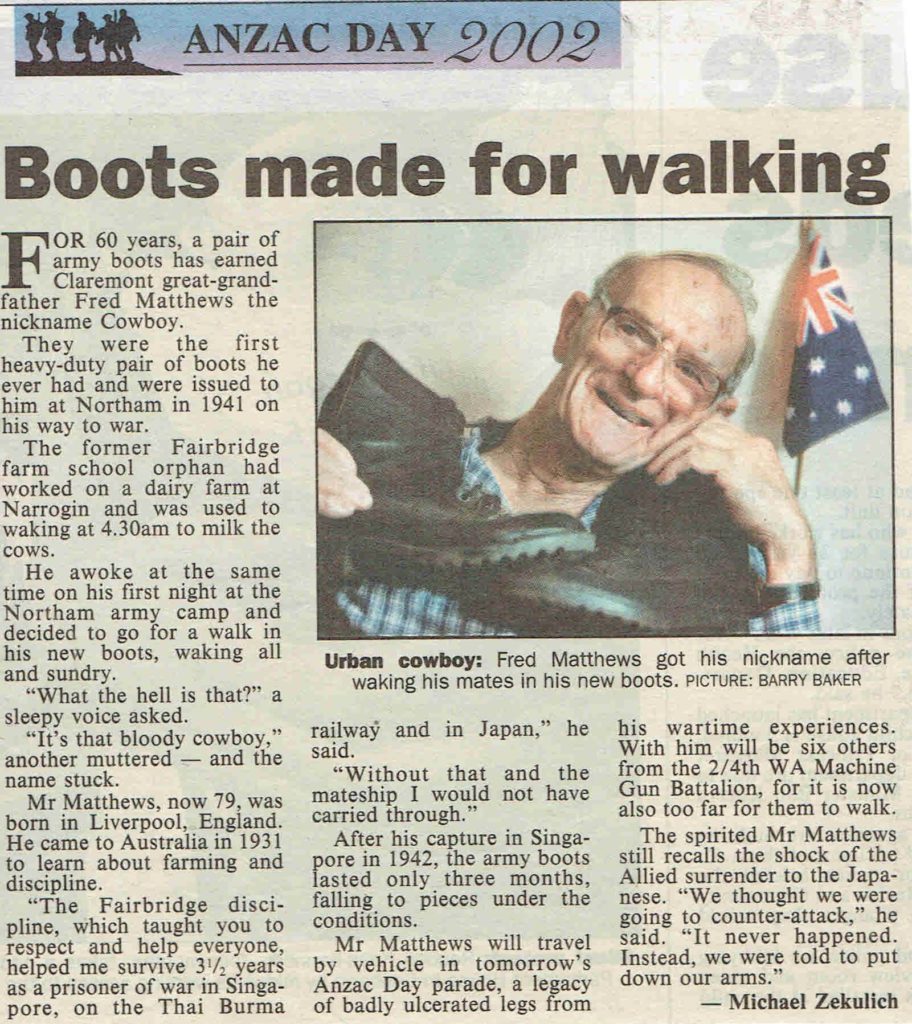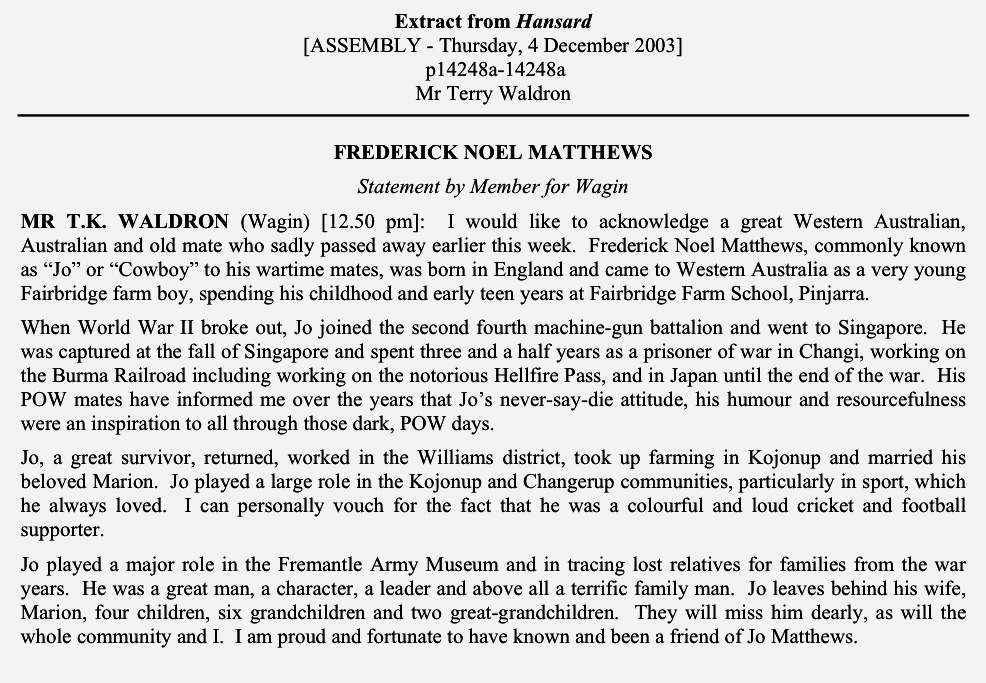The Soldier's Details

- Surname:
- Matthews
- First Name:
- Frederick Noel
- Nick Name:
- Cowboy
- Rank:
- Private
- Regimental #:
- WX17000
- Company:
- 'E' Company, Special Reserve Battalion, No. 1 Platoon.
- Enlisted:
- 13.10.1941
- Discharged:
- 28.02.1946
- DOB:
- 23.12.1923
- Place of Birth:
- Liverpool, England
- Father's Name:
- Not Known
- Mothers's Name:
- Elizabeth Matthews
- Religion:
- Church of England
- Pre-war Occupation:
- Farmhand
- Singapore:
- Selarang Camp Changi, Adam Park, Johore Bahru, Selarang Barracks Changi, River Valley Transit Camp
- Force:
- 'D' Force Thailand, S Battalion
- Camps Thailand:
- Tarsau, Kanu II, Hintok River Camp, Kinsaiyok, Tarsau, Tamuang
- Camps Japan:
- Yamane, Nihama
- POW#:
- 3/8657, 8814, 1667
- Japan:
- Rashin Maru Party
- Return Details 1945:
- Wakayama-Okinawa, USS Sanctuary, Okinawa-Manila, USS Bingham, Manila-Sydney, HMS Speaker Sydney, Sydney-Melbourne-Perth by troop train.
General Description
Matthews was born to a young single mother in Liverpool. She fortunately lived with her parents and siblings and with assistance from her mother, never gave away her son Noel for adoption. When he was about 7 or 8 years old, Elizabeth Mathews was told of an organisation called Fairbridge Children, run by Kingsley Fairbridge in Western Australia. Noel was then living with his grandparents. He was at an impressionable age, seemed to be getting into trouble at school and with local children residing around the docks of Liverpool. Elizabeth’s father William Matthews (a senior Police Officer) wanted peace and quiet at the family dining table instead there was kicking beneath the table from ‘Joe’ and screams from Noel. Elizabeth’s younger brother ‘Joe’ resented having a younger child about, especially one with blonde hair, sweet face and happy smile who had won his Grandparent’s attention. Elizabeth was under pressure to ‘do something’ she applied to the Kingsley Fairbridge scheme – took a risk, in fact a huge risk – she accepted an opportunity for Noel to go to Australia as a Kingsley Fairbridge Farm Schoolboy.
Noel’s mother did not think she would not ever see her son when she was notified he was Missing in Action then a POW of Japan. They did meet up again many years later.

Above: Fairbridge – ‘Cowboy’ or Noel Matthews standing on far right.
He always believed he was fortunate to live in Australia! He arrived in Australia 14/5/1931 on ‘Largs Bay’ aged 8 years. Also on board was Reginald Gerald Tooze WX16323. They were housed in ‘Nelson’ Cottage.
Cowboy was with ‘E’ Force during the fight to save Singapore. Most of ‘E’ Force was made up of reinforcements, too many very young men with insufficient training and for some, had enlisted in 1941 as late as November/December.
Please read further details of the demise of ‘E’ Force from the writing of Saggers as they ran into a Japanese ambush at South West Bukit Timah, losing most of the officers and too many young men. Only 88 of the 200 men survived. Cowboy says he was lucky. Those still alive ran for safety, scattering in all directions. He ran into Don Company, 13 Platoon which was made up mostly of well trained machine gunners, having trained at Woodville SA, and Darwin they had faced the first wave of Japanese and had been fighting for their lives since first night of the invasion. He remained with them during the last three days of fighting.
Cowboy said “I was lucky – during the ambush, everybody ran in different directions, some straight into the Japanese. I ran straight into ‘D’ Coy, 2/4th”.
Matthews left Singapore to work on the Burma-Thai Railway with ‘D’ Force Thailand, S Battalion.
Please read about ‘D’ Force Thailand S Battalion
Approximate date of Camps:
17.02.42 Changi, Singapore
23.03.42 Johore Bahru, Malaysia – six weeks building Japanese Shrine – Malaria evident.
04.04.42 Adam Park, Singapore
06.11.42 Syme Road, Singapore
29.12.42 Changi, Singapore
14.03.43 Left Changi, Singapore by train for Thailand.
18.03.43 Arrived Bampong, Thailand (at that time end of Rail link)
19.03.43 Kanchanaburi, Thailand by trucks.
24.03.43 Tha Sao/Tarsau
25.04.43 Kanu 2 – Cholera broke out.
16.07.43 Hintok – building Bridge
23 Dec 1943 Birthday
20.02.44 Tamarkan
27 Feb to 12 May 1943 Tarsau Hospital Camp – chronic Malaria. Medical Record recorded.
12 May 44 Released from Tarsau to Tamuang. Almost immediately drafted into work party to Japan – Rashin Maru.
Entrained to Singapore.
26.06.44 Arrived River Valley Road Transit Camp, Singapore
01.07.44 Embarked for Japan – 70 day sea journey to Moji, Japan. Rashin Maru was junk ship. Captain was an older man with years of experience. Survived typhoon, American blockade at Manila where they remained several weeks.
Hospitalised in Japan to have operation behind knee a Buruli or Bairnsdale ulcer. (inward growing ulcer).
Yamane Copper Mine, Shikoku Island
Nihama Copper Refinery Shikoku Island
12.09.45 Released at Niihama
14 Sep 1945 Boarded Hospital Ship.
Return Details: Nihama to main Island of Honshu by ferry
Wakayama via Osaka by train.
Hospital ship USS ‘Sanctuary’ to Okinowa
‘Liberty’ ship to Manila
Below: Cowboy admitted to hospital at Tha Sao with Chronic Malaria on 27th February 1944 and discharged on 12th May 44, just before being transferred to the new Group 4 Base camp at Tha Muang where he was soon to be “selected” by the Japanese as fit to work in Japan. So while we know Group 4 men were predominantly sent from Kinsaiyok or elsewhere in the region to their then Base camp at Tha Sao when the railway was completed in that area, having this (wonderful) hospital record is proof positive that he was there. (We wish to acknowledge this information gratefully received 22 Oct 2022 from Terry Manttan TBRC – Kanchanaburi, Thailand)

Below: Cowboy’s record at Niihama Camp. His name was not included amongst the list of Australians, however attached as below – possibly because his NOK is his mother with a UK address!

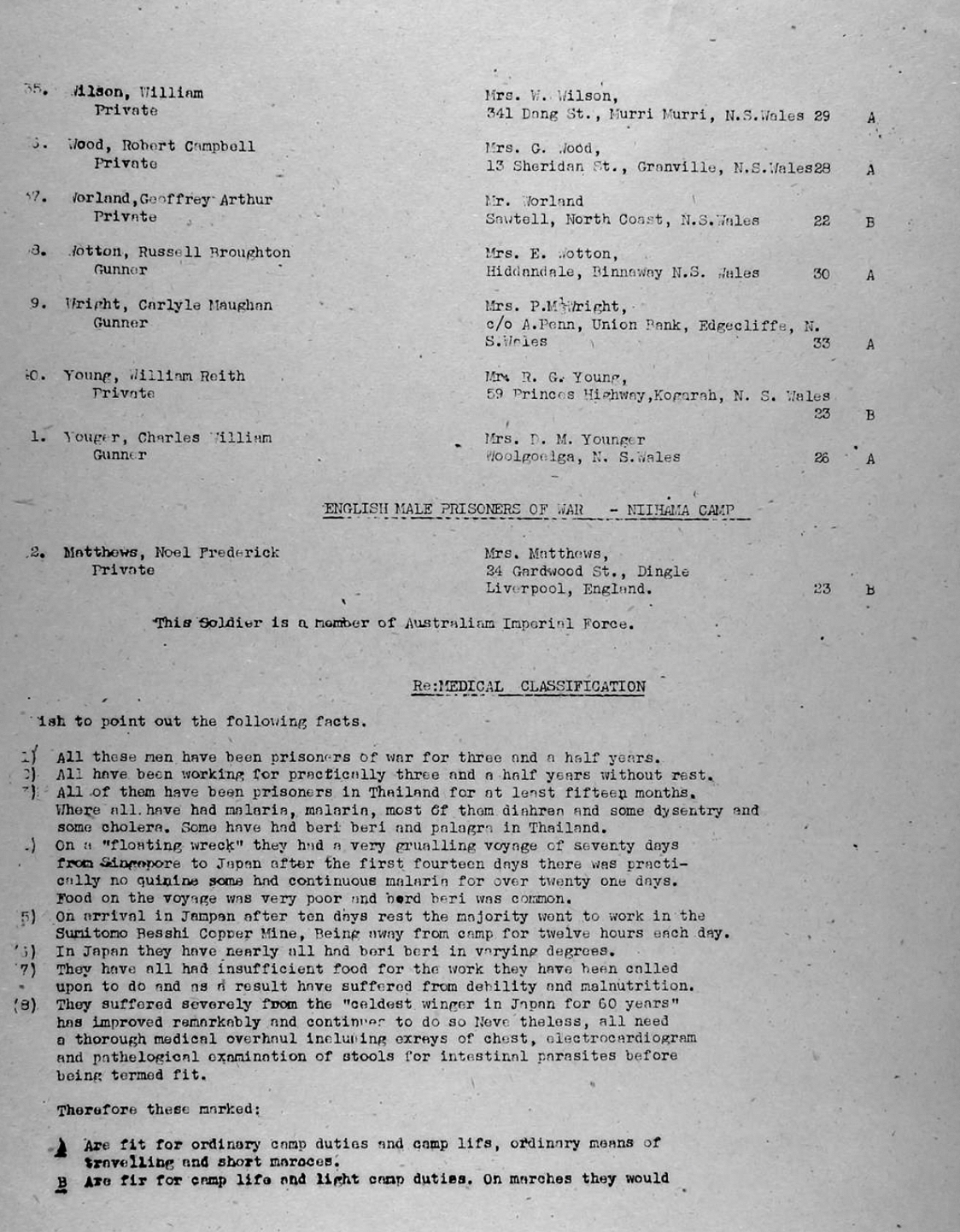
HMAS ‘Speaker’ from Manila to Sydney
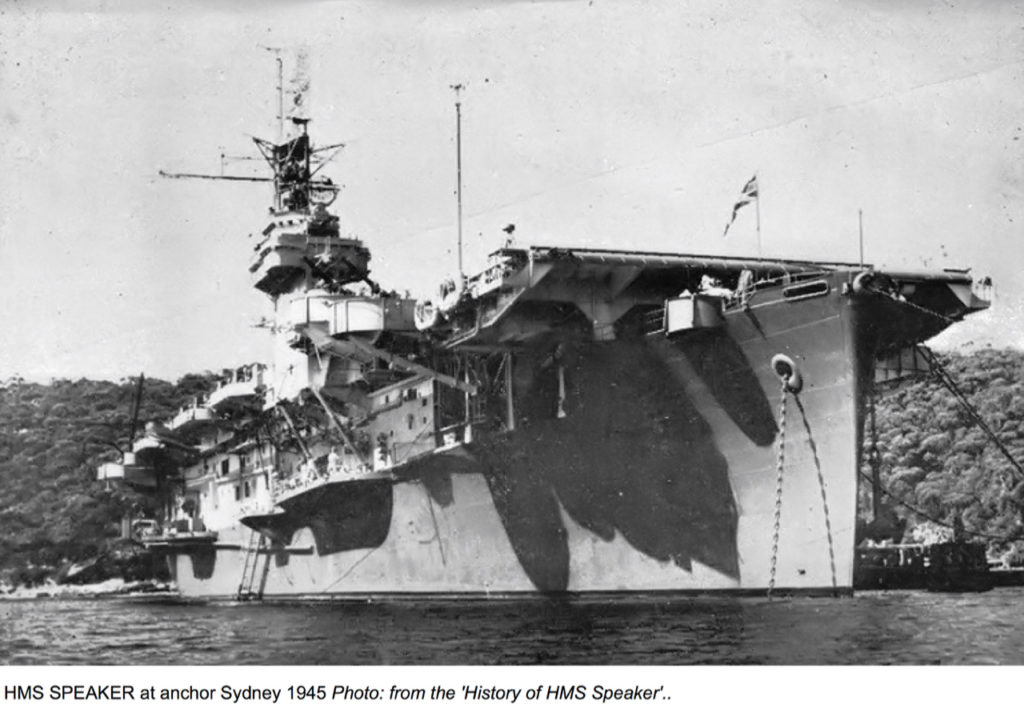
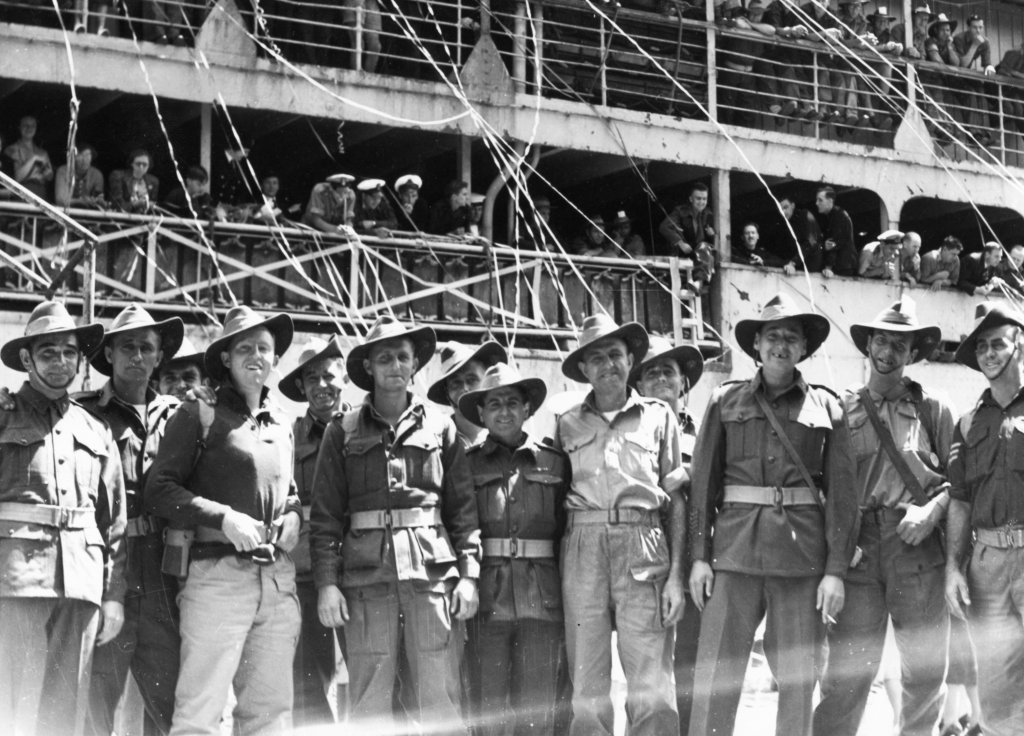
Train from Sydney to Melbourne (one of many former POWS who refused to board very overcrowded ship ‘Dominion Monarch’ in Sydney – Cowboy’s record says he was AWL).
Melbourne to Perth by Civilian DC 6 Airliner
Once released from his Japanese POW Camp, Cowboy’s journey home to Australia from Manila was via ‘Speaker’ sailing into Sydney. The men were supposed to board ‘Dominion Monarch’ at Sydney, however Cowboy was one many former POWs who walked off due to severe overcrowding. After what they had survived, they were not going to sail on an overcrowded ship, probably without bunks and possibly on deck. This large number of former POWs sought alternative transport. The next leg was via train from Sydney to Melbourne to Perth. Cowboy at arrived at Perth by train where all former POWs and 2/4th boys all piled out, crazy with excitement (and probably anxiety) to meet with their families for the first time in almost 4 years – with no family to great him and no family home to go to, Cowboy was a little overwhelmed.
He had been waiting 4 years to “go home” – being an Old Fairbridgian and barely 18 years old when he left WA, he certainly didn’t have anybody waiting to meet him or a family home to make his way to.
The men soon departed with their families – an unexpected voice loudly called out “Come on Cowboy, you are coming home with me”. It was the voice of Harold Jacobs WX10804. Harold had realised Cowboy’s dilemma and acted with sensitivity and kindness.
Cowboy was to spend a few days with Harold Jacobs and his family before he headed off and made his way back to Fairbridge!! The men continued to look out for each other.
At Pinjarra he was once again able to call Fairbridge his ‘home’ although he had not lived there since he was 14 when he was sent out to work at his first job. The former students were able to return to Fairbridge anytime, mostly seeking Christmas and summer holidays. They would be required to pay a small fee towards food and lodging.
The Old Fairbridgians Club house had been established to provide accommodation for former students (female and male). The top floor of the 2 story building was a dormitory and became filled with returned servicemen and servicewomen who had survived the war.
Cowboy never forgot Harold’s act of kindness at that memorable time in his life.
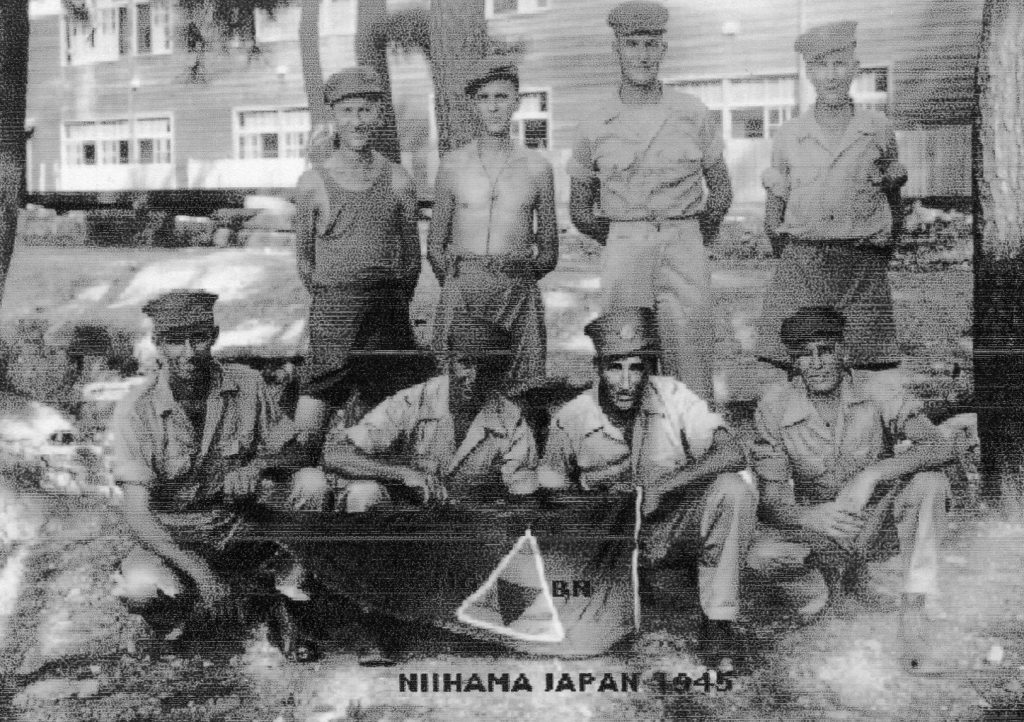
Front: George Chatfield, Norm Thompson, Claude Dow, Andrew “Mick” Lambie


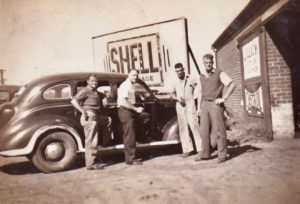


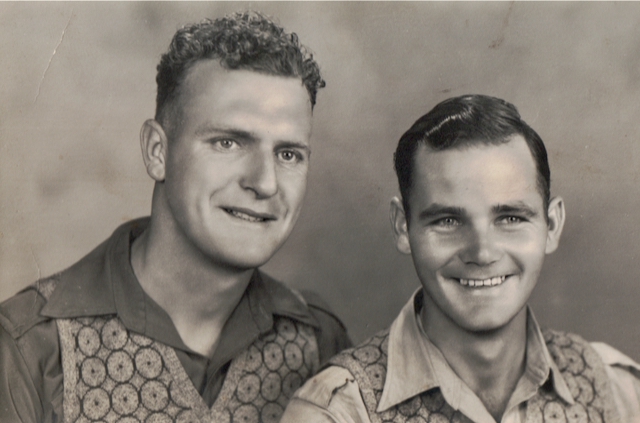
Above: Cowboy with his close Fairbridge mate, Bill Tatchell. Tatchell was standing next to Cowboy at Northam Training Camp when a dividing line was ‘drawn’ by an officer between two mates standing in line Bill went off with another Battalion and survived the war. Cowboy was sent to 2/4th.
Cowboy enlisted at Claremont on 13th October 1941. At 18 years he was underage. He was excited, no more milking cows and getting up at 4.00 seven days a week, free from ties and responsibilities to Fairbridge and best of all, a chance to travel the world! (Officially Fairbridge students were Wards of the State until 21 years old). It was a rather exciting time – had they known what was ahead of them perhaps they would have absconded and forgotten about the few months training ahead of them!
Developments on the Malaysian war front changed the initial planned direction for those in Northam and elsewhere. The Australian Government’s War Cabinet made the disastrous decision to redirect the well trained 2/4th Machine Gun Battalion then stationed in Darwin and destined for the Middle East, to Malaysia to support the ill fated Australian 8th Division which with the British was already in rapid retreat from the advancing Japanese Imperial Army.
Cowboy now training with 28th Battalion, was one amongst 300 raw recruits ordered onto the parade ground at Northam Army Camp Dec 1941. A senior officer divided the men into two groups of 150 each. The cut-off point was between Cowboy 17000 and his best mate from Fairbridge who was No 17001 (Bill Tatchell). With his group of men Cowboy was informed they were to take a few days leave, return to Northam and prepare for overseas service. (2/4th sent to Singapore and other 150 men were going to Middle East.) The best mates parted company. Tatchell also survived.
Cowboy prepared to train from Northam to Perth as one of 146 reinforcements on 15 Jan 1942 to board ‘Aquitania’, anchored in Gage Roads off Fremantle. Apparently these reinforcements firstly marched through Northam.
It was not until the reinforcements arrived in Fremantle and saw the ‘Aquitania’ with more than 4,000 troops on board including the 2/4th who had been ordered from Darwin via Sydney, anchored in Gage Roads did they realise they were to board this huge ship.
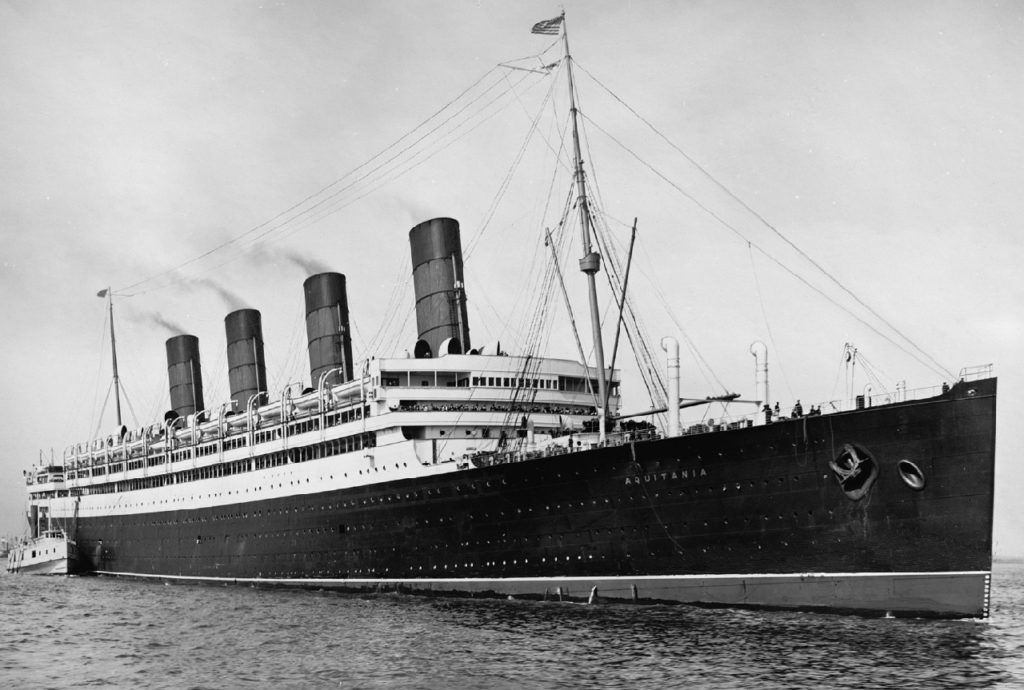
The reinforcements boarded pontoons packed with supplies, sailed to ‘Aquitania’ where mayhem met them! Large numbers of men on-board ‘Aquitania’ were attempting to go AWOL to see their families. It is believed at least 200 2/4th men managed to get to shore and see their families and return by next morning. It was a frightening experience as the pontoons bounced around on the water with those illegally climbing down from the ship’s portholes and other outlets whilst the recruits were ordered to climb on-board. In the meantime, supplies were being transferred onboard.
The ‘Aquitania’ sailed the following day, 16th January. 90 odd well trained machine gunners failed to reboard in time, many of who were locked up by over zealous local police, and MPs unable to persuade their gaol-keepers to allow them to leave.
Please read about the 2/4th Men who were AWOL
Of the 146 Reinforcments about half formed ‘E’ Coy Special Reserve Battalion and the other half reinforced other Platoons, now depleted of those 90 machine gunners.
Please read about the men of E Coy SRB
By Feb 12 1942, Bukit Timah was under Japanese control the SRB was with an Indian Platoon and British Platoon who failed to be notified of an earlier withdrawal and after heavy fighting managed to break out of the Japanese stranglehold, were withdrawing their position they walked about a mile through scrub into a Japanese ambush at SW Bukit Tmah. All hell broke out with those in front killed and those behind running to escape. The Japanse were finally overcome but at a terrible cost. SRB had 88 out of 200 men standing – many were behind the lines and the wounded left behind.
Cowboy said he just ran and ran, he was fortunate he found 2/4th’s 13 Platoon made up of trained machine gunners and at this time, battle experienced and remained with them until capture.
The fighting to defend Singapore barely lastedone week but in that time ‘E’ Company (made up of mostly reinforcements) suffered he largest number of deaths, including four young men from Fairbridge. It had been a terrifying ordeal amidst the mayhem of the Allied Forces fighting to defend Singapore. The 2/4th MGB did not fight as a Battalion, instead the Companies were sent to various locations to support 8th Division.
A month later, on 15 Feb 1942 Cowboy was a POW of the Imperial Japanese Army.
Following capitulation in Singapore 15 Feb 1942 Cowboy was sent to Changi (Selarang Barracks) initially, then with work parties to Adam Park, Johore Bahru, Sime Road and back to Changi before departing by train for Thailand.
Cowboy was selected to go to Thailand to work on the railway with ‘D’ Force, S Battalion. ‘D’ Force was made up of 5,000 Australian and British soldiers who left Singapore between 14-23 March 1943. This Force was divided into 3 sections: S Battalion commanded by Lt. Col McEachern; T Battalion commanded by Major E J Quick and U Battalion commanded by Capt.Reg Newton. Overall joint command was Australian Lt. Col McEachern and British Lt Col GG Carpenter.
Please read further about ‘D’ Force Thailand, S Battalion.
‘D’ Force worked over a large area of the railway between Tarsau and Rin Tin in Thailand. Many of the men worked on the Konyu Cutting (Hellfire Pass). The largest group of 2/4th men together were selected for ‘D’ Force.
The train journey from Singapore was a hellish one. POWS were crowded into small trucks squeezed in by their Japanese guards for what was to a 5-day 4-night rail trip to Bampong, Thailand. The days were stinking hot and the men found the nights freezing cold. Without sufficient room they were forced to take turns to lie down. They stayed overnight at Konma transit camp and headed out the next day on a 49 km trip by truck to Kanchanaburi.
Initially they were trucked to Tarsau via Tardun where they worked clearing a path for the future railway line for a few weeks. Working at Tarsau did not prepare them for what was ahead. The Hellfire Pass Cutting. Cowboy arrived with S Battalion at Konyu II on 25 April 1943.
This was hell.
Most without shoes, clothes and dressed only in ‘Jap Happys’ they were every day subjected to injury from flying stone flint as they proceeded with ‘hammer & tap’ day in and day out. Food was minimal and beatings frequent. The trek every day day from their camp was long and tortuous for the ill and injured as they returned at night. Beatings and tropical illnesses including cholera raged through the camp taking lives.
Cowboy was teamed up with ‘KK’ MacDonald WX8621 to work hammer & tap. Cowboy was probably one of the youngest and ‘KK’ considered an older soldier at 25 years! Everybody loved ‘KK’ he was a popular bloke. In November 1943 Cowboy was on ‘tap’ – holding the spike to the rock face while ‘KK’ had the hammer. Cowboy got the shock of his life as he felt hammer smash into his fist and looked up to see ‘KK’ falling to the ground. A Japanese guard immediately ran over thinking the POWs were fooling around. Of course they weren’t. ‘KK’ was lying unconscious. The guard recognised another cholera victim, and ordered McDonald be carried back to Camp.
Cowboy was devastated and shocked as were all the blokes. KK was never to be seen again.
The men arrived back at Camp to discover KK had been evacuated (to Tarsau Hospital Camp) where he died on 25 November 1943, aged 25 years. Cowboy was always grateful that they heard news of KK’s death, because mostly when the sick were evacuated those left behind never heard anything further.
The men suffered beri beri, dysentery, ulcers and endless tropical diseases compounded by lack of food and medicine and working like slaves. The POWs were subject to bashings by the Japanese and Korean guards. They required no reason to lash out at a POW and were struck with unexpected violence and rifle butts.
From Konyu II he was sent to Hintok, Kinsaiyok (then to Tarsau Hospital Camp with malaria before Tamurang.
It was at Tamurang during June 1944 and after the Railway line was completed that Cowboy was selected to go to Japan with ‘Rashin Maru’ Party later to be named ‘Byoki Maru’ the sick ship. They were later entrained to Singapore.
Please read further about ‘Byoki’ or ‘Rashin’ Maru.
The men who made up ‘D’ Force S Battalion did not always remain together nor move to the same camps. Sometimes mates met up several months later. The Japanese ensured POWs were regularly split up.
Sickness often kept patients behind to recover whilst the remaining POWs moved on. Small groups of POWs were often ordered to move to other camps (leaving behind the main group) sometimes these camp sites provided minimal accommodation of sorts – often in poor condition and even no shelter. The POWs may be gone for a couple of days, or move onto another POW group Camp. Remember Camps and locations did not have signs to tell the POWs where they were – Japanese Guards did not tell them and their knowledge was limited.
In fact many camp names were unknown to POWs. Camps were given various names, pronunciations and spelling. If there were Camp names (and there were not) who could read Japanese or Thai?
Cowboy left Tamurang on 21st June 1944 in a party of 900 Australians, travelling by train arriving Singapore 26th June and were marched to River Valley Camp. He had worked 18 months on the Burma-Thai Railway and survived.
The POWs knew of the Allied attacks on Japanese shipping and also knew of the sinking of several POW ships.
Several days later on 1st July 1944 the group was marched to Singapore docks from River Valley Road Barracks. They were shocked to see the ship they were to board to take them to Japan. The ‘Rashin’ Maru had sustained obvious damage from Allied bombing. Worse still it was a rust bucket and an old ship (from 1921) The Australians quickly renamed the ship Byoki Maru. The sick ship. They boarded knowing there was every chance they may never reach Japan.
Below: ‘Rashin’ Maru in its heydays.
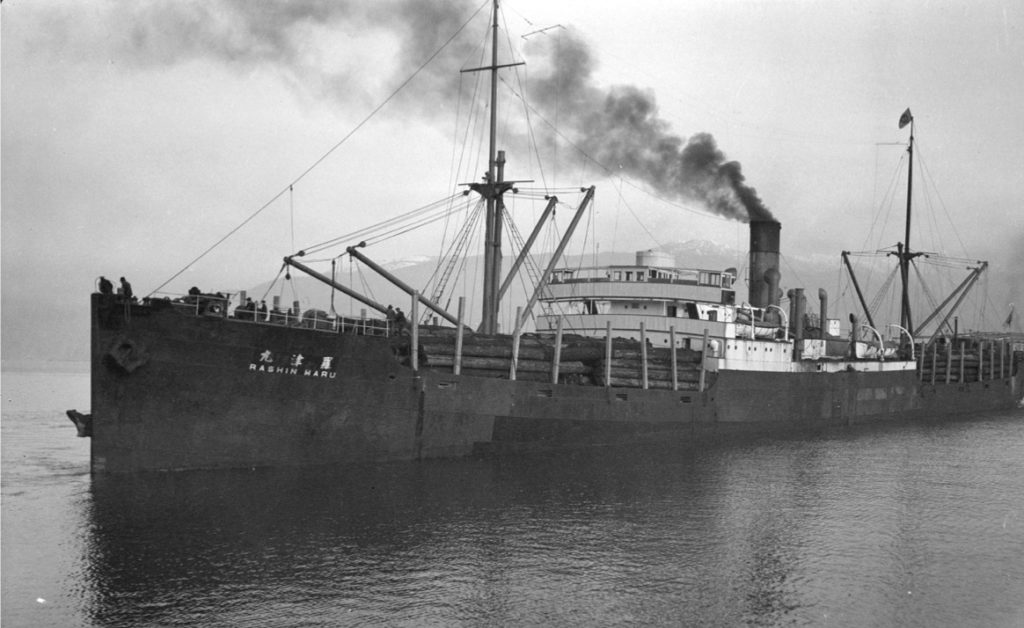
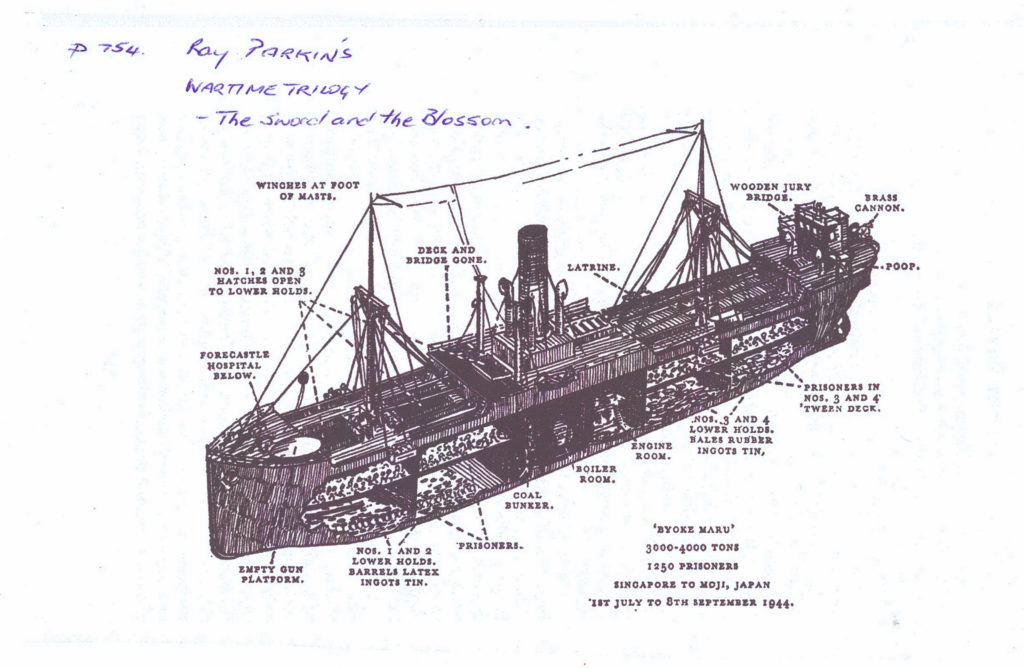
It was to be a 70-day very long and at times danger-filled journey to Japan. The ‘Rashin’ Maru sailed at 5pm arriving four days later at Miri, Borneo. Two days later on 10th July 1944 the ship anchored off Miri and sailed 12th July headed for Manila and arriving 16th July. This was a terrible time for the POWs with the extreme humidity. They were allowed on deck for short periods of time, but it was so hot standing on the deck the men didn’t know which was worse – inside the hull expiring or outside roasting.
August departing at 10pm. The ‘Rashin’ Maru had attempted several times to leave Manila but returned to harbour because of American submarine attacks. The ship finally sailed on 9th August 1944.
10th August they encountered a submarine attack. The captain took the ship close to shore anchored for 2 days.
13th August a terrific storm hit the coast and ‘Rashin’ Maru was forced to leave the convoy again that night to seek shelter near a small island.
11th August ‘Rashin’ Maru anchored half day off south Formosa.
16th August arrived Keelung, North Formosa.
27th August sailed from Keelung at 9am and returned.
28th August ‘Rashin’ Maru sailed 9am.
30th August Anchored at Nowa.
1st September sailed from Nowa.
3rd September anchored off Isle of Keesu.
4th September sailed.
6th September Anchored Kokoshima. Arrived Moji 7th September.
8th September 1944 disembarked and marched to stables and divided into work parties. The POWs were shocked they had actually arrived safely in Japan and now faced the cold Japanese winter temperatures. They had only known tropical weather for the past 3 years after Thailand and Singapore.
Australian POWs had zero knowledge of Japanese culture and Japan. Japan was to have the coldest winter in 30 years.
But first ‘Cowboy’ had to deal with his health. He had developed a ‘blind’ ulcer behind one of his knees during the 70-day sea journey from Singapore to Japan! Of all the luck – he was never once sick whilst on the Railway or so he claimed – but he did spend several months at Tarsau with malaria after the line was completed.
(Mycobacterium ulcerans, also known as Buruli or Bairnsdale ulcer, is caused by a bacterium thought to live in the environment. It produces a toxin damaging to the skin and underlying tissues. The infection usually begins as a painless spot or pimple which slowly grows bigger and forms an ulcer – if not treated it ‘eats’ away through the flesh to the bone. Buruli ulcer usually progresses slowly over several weeks. Occasionally it can develop more rapidly. An ulcer may not be initially present. It can occur anywhere on the body but it is most common on exposed areas of the limbs, such as ankles, back of calf, around the knee, or forearms or around the elbow.)
He was sent to a nearby Japanese Hospital to be operated on. Nobody spoke english and he was sent alone. He never really commented on this experience but the consequences physically plagued him all of his life. He required Repat shoes to be made for him to accommodate one large/swollen foot and wore stockings to his thigh to restrict the swelling of leg veins. This condition worsened with age.
General Health
Dad also suffered nervous anxiety, sometimes worse days than others. If there were other people at our home or when we were out, Cowboy worked very hard to contain his anxiety and would put on his happy larrikin face for all to witness.
He was mostly unable to cope with the noise of children playing or loud, sudden noises. Definitely not children squealing. This was even more noticeable as we children had our own families. He became deaf and sudden noises would always startle him.
Our mother was a saint when we children were at our youngest ages, She would have to have all the children in bed and asleep before Cowboy would return home in the evenings from working outside on the farm. Sometimes he would remain at the farm shed until quiet prevailed.
Cowboy could never be shut in confined spaces.
Our farming neighbours could never understand why he had no interest in purchasing a caravan and travelling in convoy with them every winter to Boome. This fear developed from two long and very crowded train journeys between Singapore and Thailand each taking between 4-5 days and the 70 days spent on POW transport ship ‘Rashin’ Maru from Singapore to Japan in 1944, mostly in the ship’s hold in very crowded conditions and rough seas.
He was rarely known not to suffer with gut problems. He suffered his whole life with his senstivie gut and his leg/foot swollen out of shape.
During his latter years he would remain sleeping in his chair until the early hours of the morning, avoiding the nightmares which came to him in the dark of night.
Cowboy & Marion
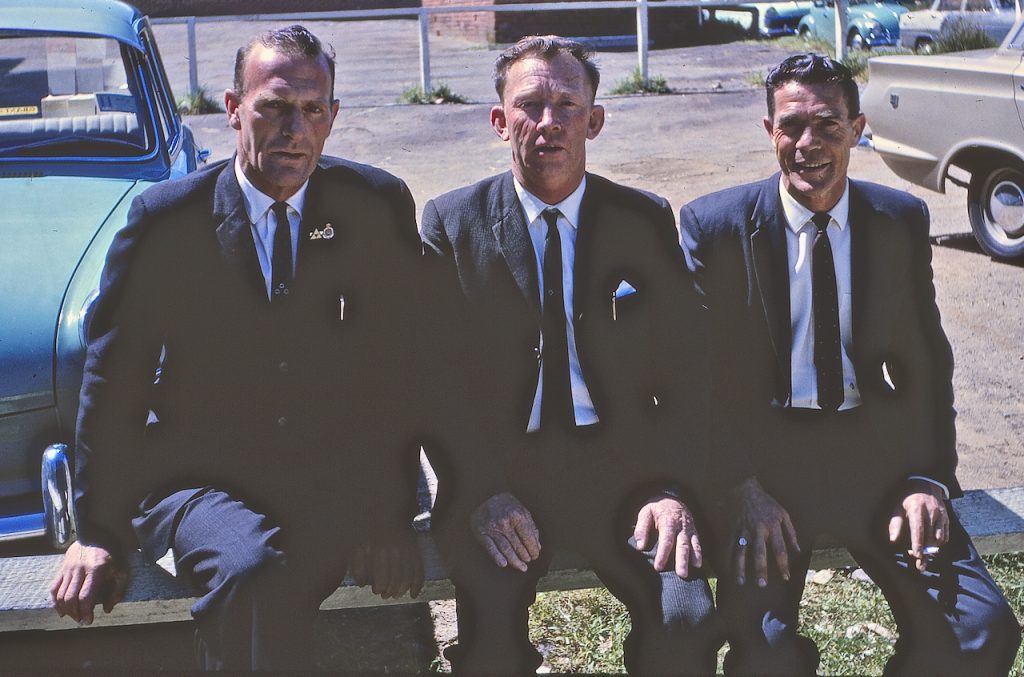
2/4th Reunion Cowboy on left.
Below: Cowboy 2nd from Left
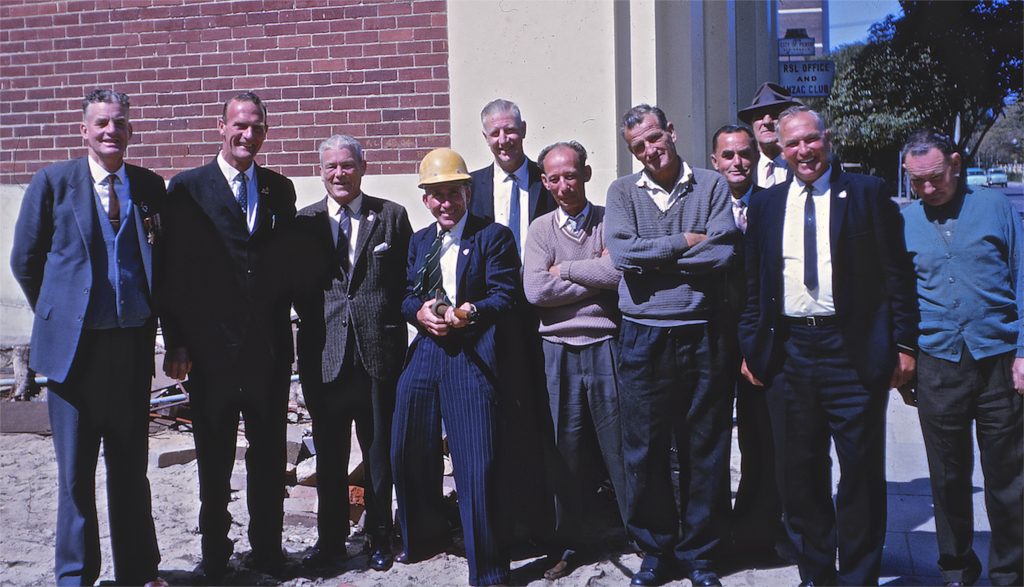
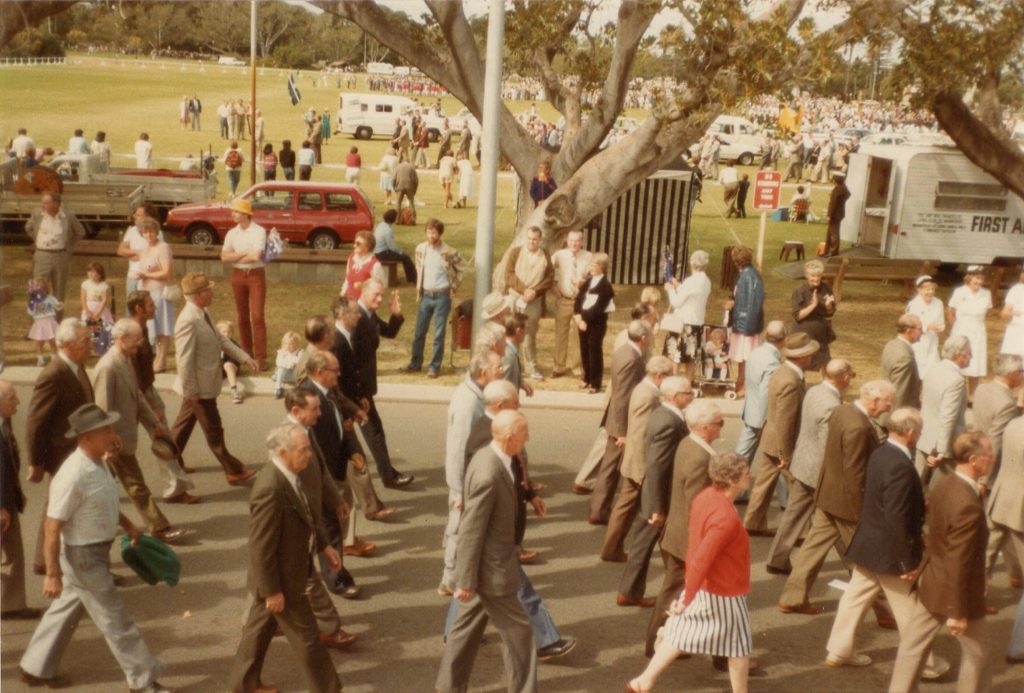
Above: 2/4th Anzac Day believed to be 1980s. Cowboy in 2nd last row far side saluting us.
Cowboy passed away aged 80yrs, December 3 2003, at Claremont, WA.

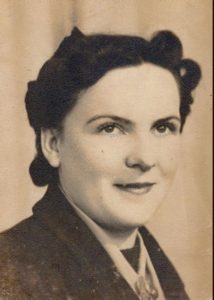
Cowboy carried this photograph with ‘Betty Oldfield’ written across the back throughout the war and returned home with it intact. He had never met Betty. In 1942 as his train from Northam passed through the hills on their journey to Fremantle and ‘Aquitania’ the train travelled slowly though the small towns – the townspeople and young girls waved and sometimes passed momentos to the young soldiers. Cowboy acquired Betty Oldfield’s photo at one of those small towns such as Mundaring.
Cowboy and Marion Matthews finally met up with Betty Oldfield one day in the 1990’s at Anzac House. Waiting in line to order their lunch they heard somebody say “Betty Oldfield” – she was standing in line! Cowboy introduced himself and told her the story of how she had been ‘with him’ throughout his terrible days as a POW on the Burma-Thai Railway and Japan!
Fate is a strange thing. What were the chances of Cowboy ever meeting up with Betty Oldfield – the girl in the photo thrown into the train as it passed through Mundaring on their way to war. Betty Oldfield could have married, changed her name, moved interstate or overseas and could have been dead. But no! She was standing in line to order her lunch at Anzac House.
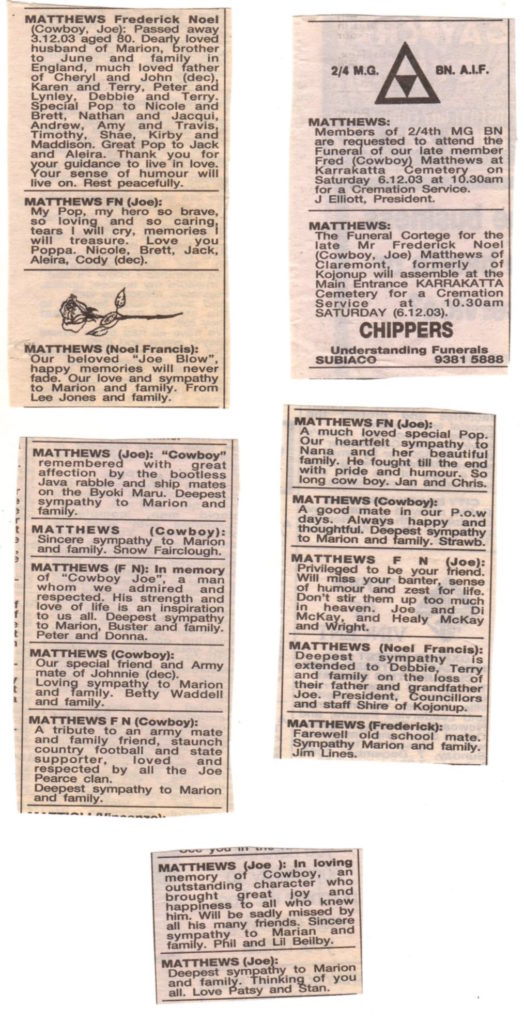
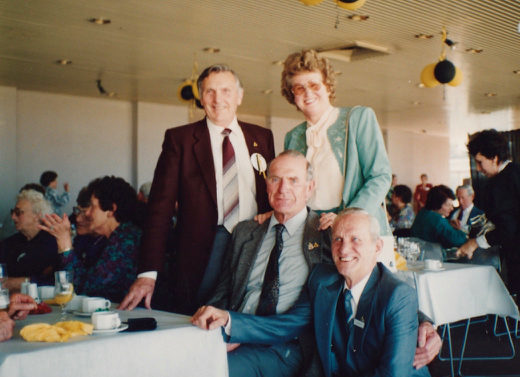
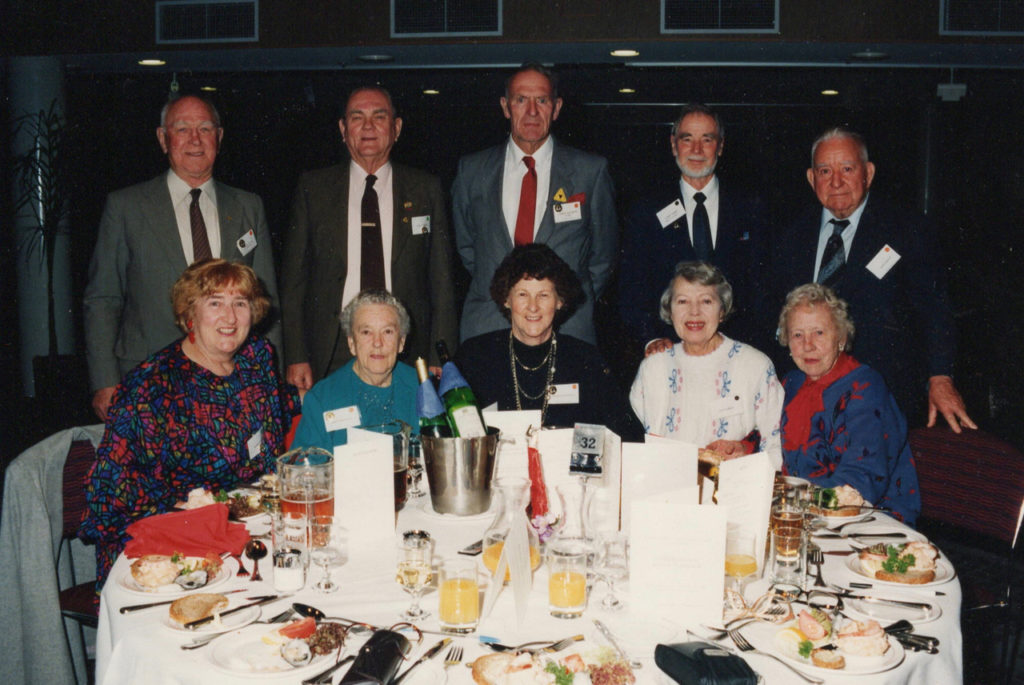
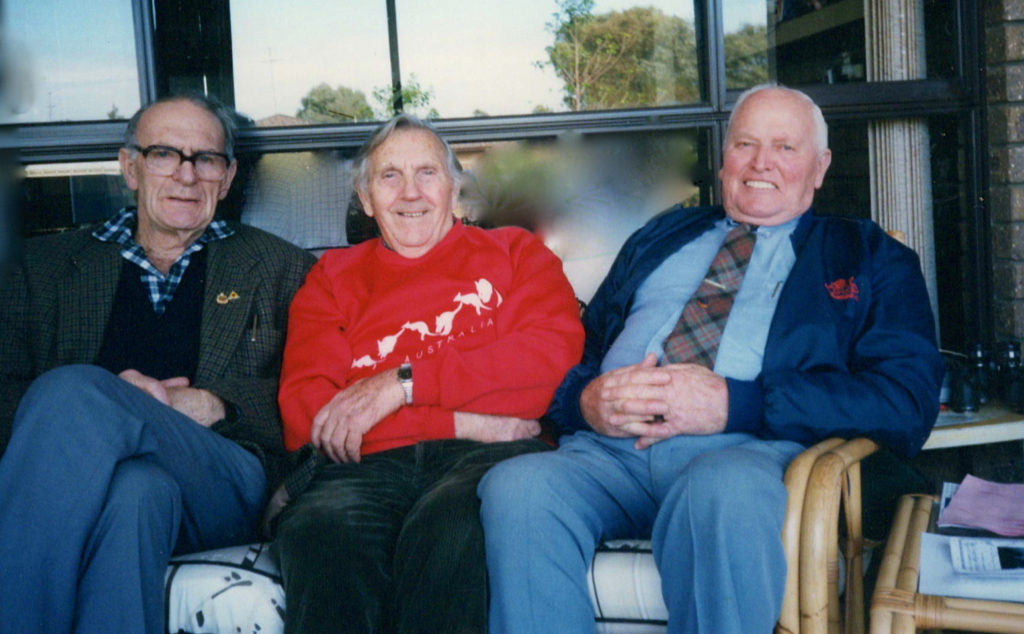
Borehole Bulletin July 1992

Borehole Bulletin October 1992
The following letter was addressed to Ted Wallin, (editor of Borehole) written by John Waddell from Newdegate.
‘Just a note to say good’day and some information on Bill ‘Jeep’ Breed’s 90th birthday in June. Hoping all is well with you as it is with Beth and I, we are shifting to Mandurah next month so may get to a few more shows.
Bill is keeping well and has a marvellous spirit for his age. His party, organised by Poll Findlay’s daughter Marg and husband Merve Saunders, was very well done. Plenty of food and drinks all day and plenty of chance to talk.
Around 35 people turned up over the day and included Bill’s friends from Perth and Newdegate, also many cards, etc. a very nice one from Dick Ridgwell which was very much appreciated by Bill. ‘Cowboy’ Matthews rang him but I was the only 2/4th present.
Bill also had a phone call from a doctor who treated him for a few years, from Cocos Island where he is now on holiday and said he’ll be back next year to see Bill.
Everyone enjoyed the party, especially Bill, who was as bright as a button at 10 o’clock at night when we left.”
__________
Below: Cowboy records his age on enlistment on 13 Oct 1941 at Claremont as being 22 years old born in 1918. In fact he was born Dec 1923.
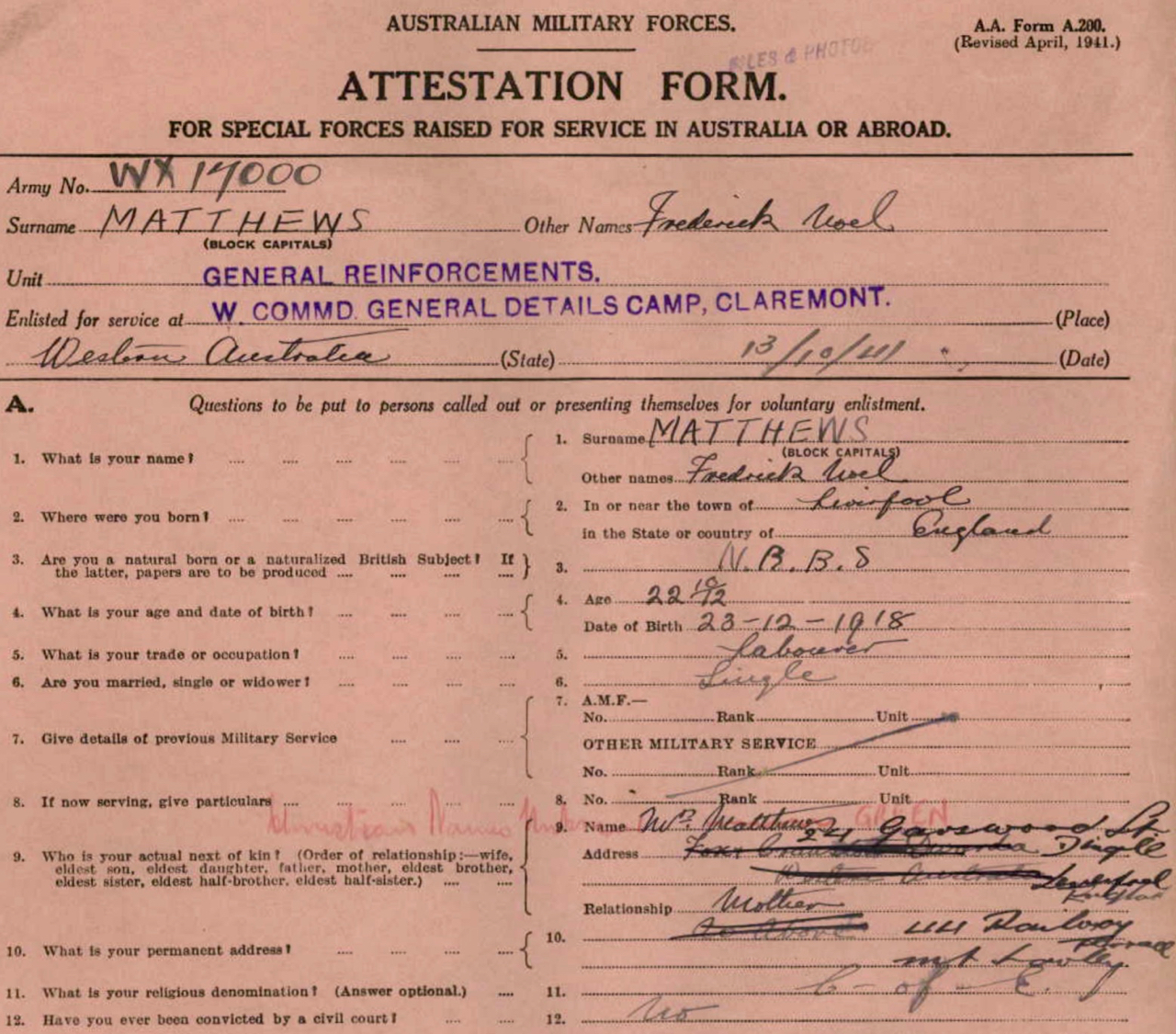
Initially he joined 2/28th. Was ‘scooped up’ with reinforcements, transferred to 2/4th on 2 Jan 1942 and sent to ‘Aquitania’ to join the Battalion sailing to Singapore. The reinforcements stood to attention at Northam – a senior officer passed in front of the new recruits counting, until he reached Cowboy WX17000 and stopped. They were to transfer to 2/4th.
From new recruits at Northam, the numbers WX17001and upwards, remained with 2/28th, Cowboy WX7000 was separated from his best friend and sent to 2/4th.
Below: Refused to sail on the ‘Dominion Monarch’ to sail from Perth back to Perth 1945. Cowboy was only one of a number of 2/4th boys, possibly 15-17 who did this – the number of returning POWs and soldiers far outnumbered the facilities of ‘Dominion Monarch’ – i.e. they had to settle for sailing back to Perth camped on deck. The former POWs were livid – they hadn’t spent the last 3.5 years as POWs of Japan to spend several days and nights camped on the ship deck, exposed to the Great Australian Bight weather conditions.
Please read about ‘Dominion Monarch.’
Instead the group of POWs took a flight from Melbourne back to Perth on 12 November 1945.
Below: Discharged from AIF Cowboy provides his age as 22 years 11 months!
The problem with his left leg would plague him all his life. Whilst in Japan he was taken to a Japanese Hospital to have a ‘blind’ abscess/ulcer operated on. This had developed at the rear of his knee during the 70-day sea journey from Singapore to Japan in 1943.
The operation was undertaken without any translation or exchange between Cowboy and nursing staff. He was returned to camp unable to walk let alone stand. Once he was considered ‘fit’ he had to work in Camp kitchen being unable to walk distances.

Below: Cowboy and Marion with their six grandchildren (probably late 1980’s)

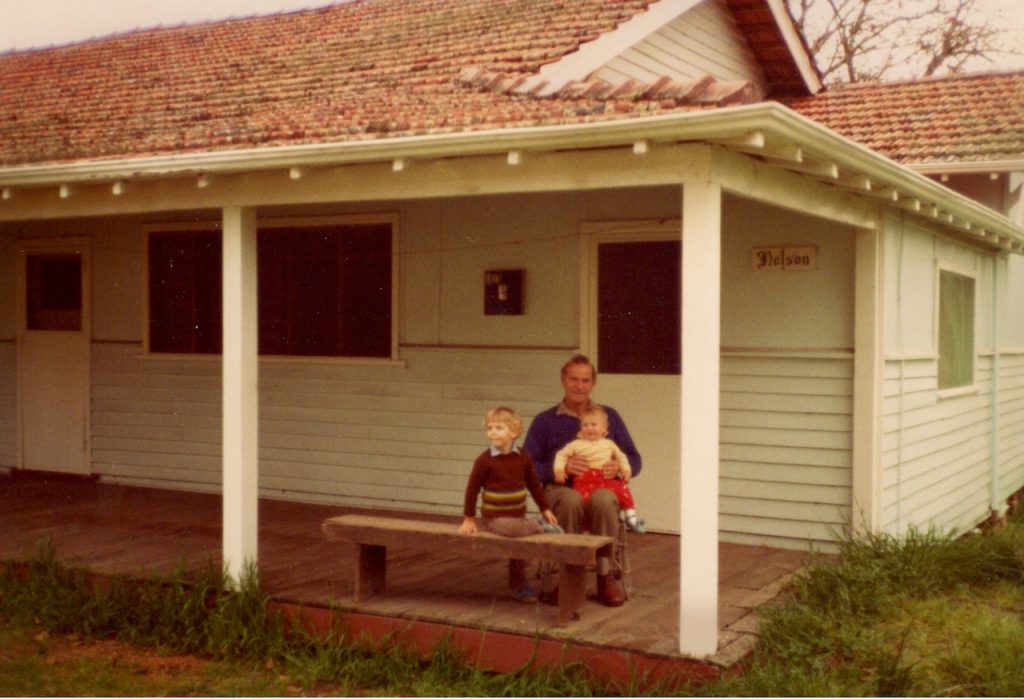
Above: Cowboy (with grandsons Andy and Tim Mellor) on the verandah of Nelson, his former home at Fairbridge as a young boy.
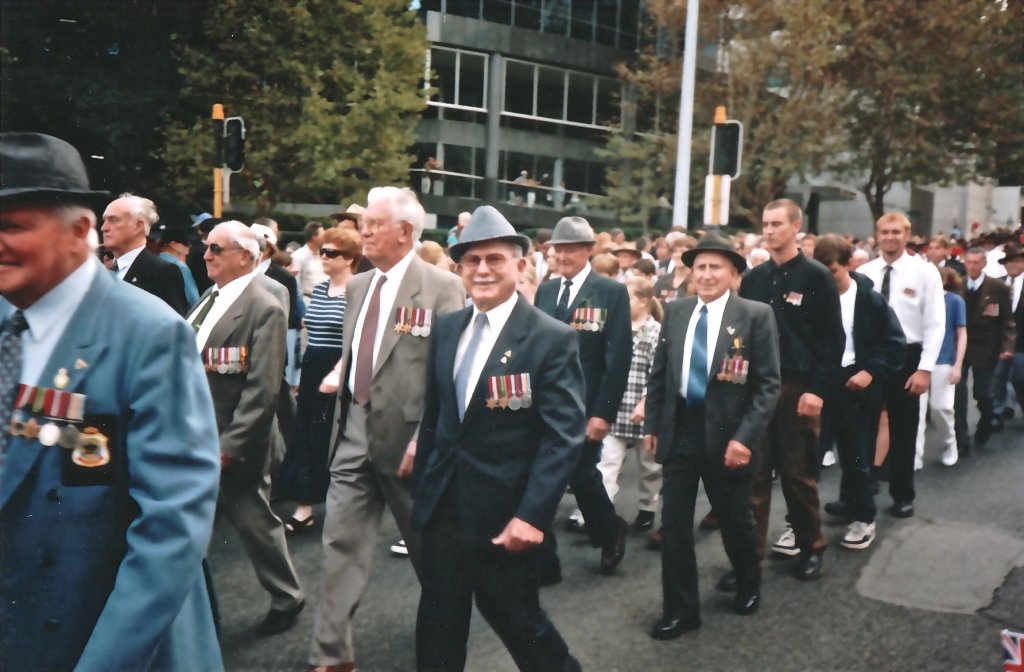
Above: Jim Elliott looking at photographer, beside him Don Wall, immediately behind Elliott is Claude Dow, followed by Tim Mellor (in Black shirt) Andy Mellor (in white shirt) – grandsons of ‘Cowboy’ Matthews.

Back: Jim Burns, John Lane, Jim Elliott, Cowboy Matthews, Frank Evans, Alf Worth, Trevor James, Wally Lynn, Les Cody, Owen Morris
Front: Greg Burdon, Ron Baddock, Des Colevas, Jim Gilmour, Joe Pearce

Above: Art by great grandson Fergus Mellor (9 years)
Below: ‘Cowboy’s’ eldest daughter Cheryl Mellor (Historian) with President 2/4th Harry Tysoe – taken Boyup Brook Sandakan 2023 Memorial Service – please read further
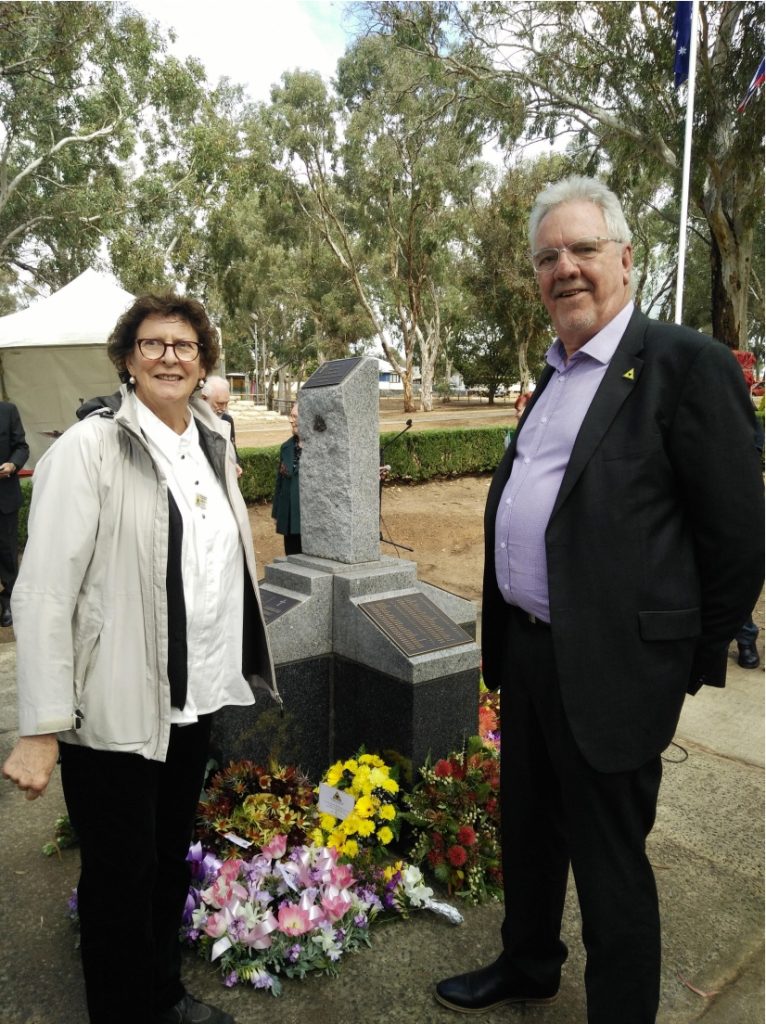
Camp Locations:
- Johore Bahru, - Malaysia
- River Valley Road Camp - Singapore
- Selarang Barracks Changi - Singapore
- Selarang Camp Changi - Singapore
- Hintok River Camp, 158k - Thailand
- Kanu II, 152.30k - Thailand
- Kinsaiyok Main, 170.2k - Thailand
- Tamarkan, Tha Makham 56k - Thailand
- Tamuang, Tha Muang 39k - Thailand
- Tarsau, Tha Sao 125k - Thailand
- Nihama, Hiroshima #2-B- Japan
- Yamane, Hiroshima #3-D - Japan

